To view credit card payment history, Settle Only or Authorize Only transactions, void credit card transactions that have not settled, or refund credit card transactions that have settled, go to Xebra Accounting > Receivables > Authorize.Net > View/Edit Credit Card Payments.
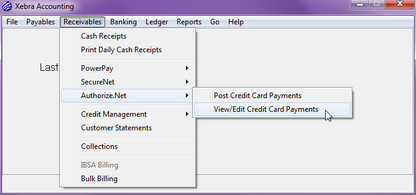
NOTE: The Accounting > Receivables > Authorize.Net > View/Edit Credit Card Payments menu will be disabled unless you have Allow view history privileges in your operator account. In order to settle, void, or credit payments, you must have Allow settle privileges in your operator account.
The View / Edit Credit Card Payments window allows you to enter selection criteria for generating a history listing. If you leave any prompts blank or zero (including date range fields), they will not be used to narrow the results for the listing. The Authorized Date range will default to the last thirty days. If you click the View button without changing any selection criteria, all transaction history will be listed.
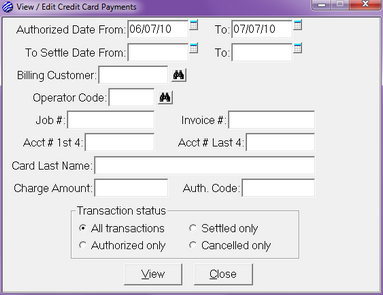
The View / Edit Credit Card Payments window lists the results of your selection. It will only contain transactions that match all of the criteria that you specified.

Notice the first two entries in the results list are Bold. These transactions are Authorize Only transactions and must either be Settled or Voided to complete the transaction. Authorize Only transactions will always be Bold and will initially sort to the top of the results list. You may resort the list by clicking on any of the column headers.
You can print the results list by clicking the Print button or you can export the full transaction details to a text delimited file by clicking the Export (full detail) button. This exported file will contain all of the transactions details and not just those shown in the results list.
A sample of the exported text file.
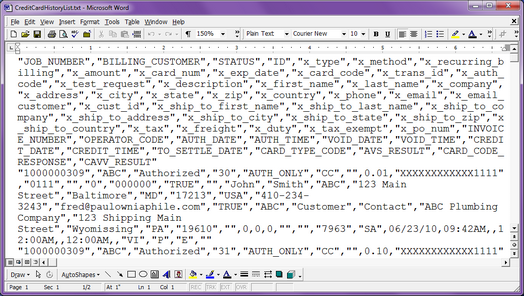
This text file could be imported into a spreadsheet or database program and used as you see fit.
Editing Existing Credit Card Payments
To edit an existing credit card payment, double-click its entry in the results list. The View / Edit Transaction window opens and displays the full details of the transaction.
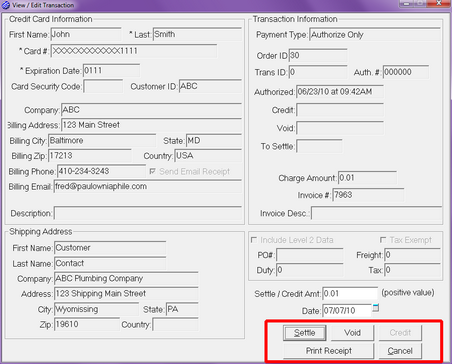
Notice that the majority of the prompts are read-only and cannot be changed. The left side of the window shows the details of the credit card used for the transaction. The right side shows the specific transaction's details. In this example, the Payment Type of the original transaction was Authorize Only. This transaction must be settled before the job/invoice will receive payment. The four buttons in the lower right corner indicate the actions that you can take on the transaction. These buttons will enable/disable depending on the Payment Type of the transaction.
Settle - This button will be available if the transaction has not yet been settled (Authorize Only). It will resend the transaction details to Authorize.Net requesting that the authorization be settled. You may settle for an amount other than what was previously authorized by entering the amount in the Settle / Credit Amt. prompt. Note that the original authorization reserved the authorized amount on your customer's credit card, settling the authorization actually begins the funds transfer. Authorize.Net's documentation states that an authorization cannot be settled for an amount greater than the original authorized amount. Xebra does not prevent you from attempting to settle for more than what was authorized; however, the results are not guaranteed.
Void - This button will be available if the transaction has not already been voided. Use this to cancel a credit card transaction. Transactions that have completely settled (the funds have been transferred by your customer's bank) cannot be voided by Authorize.Net. However, the time period between requesting the settlement and the settlement actually completing is somewhat variable. Xebra allows you to attempt to void a transaction after it has been requested to settle. If you receive a declined message stating that settled transactions cannot be voided, you must then credit the transaction instead. Xebra will reverse any original payment by creating a negative payment to the associated job/invoice. The date of this payment will be the date entered in the Date prompt.
Credit - This button is available if the transaction has been previously settled. Use this to refund your customer. The credit action will create a new credit card transaction for the amount of the credit. You may credit any amount less than the original settled amount. Note that Authorize.Net only deals in positive amounts, so always enter positive amounts in the Settle / Credit Amt prompt. Xebra will reverse the original payment by creating a negative payment to the associated job/invoice. The date of this payment will be the date entered in the Date prompt.
If you credit a customer and create a Xebra credit job, finalizing the credit process requires two steps. First, credit the Authorize.Net credit card transaction as explained above. Next, go to Accounting > Receivables > Cash Receipts. Enter a new check for the customer with a zero amount. Make a distribution to the original job/invoice for the amount of the credit (positive amount) this will pay the original job/invoice in full. Then make a distribution to the credit job/invoice for the amount of the credit (negative amount). In effect, the Xebra credit job offsets the remaining balance of the original job/invoice.
Credit Card Receipt - This button is for printing Credit Card Receipts and is available regardless of the credit card payment status. In the example below, "Authorize and Settle" appears on the receipt to show the status. There are 4 different words/phrases that may appear here: Authorize and Settle, Authorize Only, Void, and Credit.
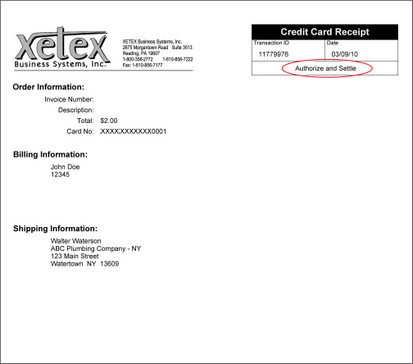
NOTE: The above actions (Settle, Void, Credit, and Credit Card Receipt) will be disabled unless you have Allow Settle privileges in your operator account.
If the action (Settle, Void, or Credit) completes successfully the Edit / View Transaction window will close. If the action was declined for any reason, you will be presented with a message box containing a short explanation of the problem.